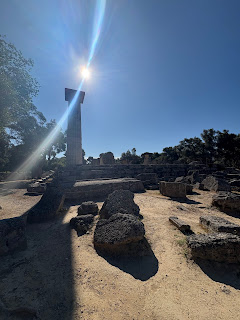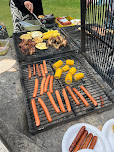Today marked the end of an unforgettable chapter: our last day on the Olympic Odyssey trip. It’s hard to believe how fast time flew. From city to city, stadium to stadium, we’ve explored the legacy of the Olympics in ways that textbooks could never explain. And fittingly, we closed it all out in the birthplace of the Games, Greece.
Our day started with a visit to the 2004 Olympic Stadium in Athens and then part of the OAKA (Athens Olympic Sports Complex). It was surreal stepping into a venue that once buzzed with global energy just two decades ago. We got to walk the track, and for a brief moment, I imagined what it must have felt like to compete under the roar of a crowd. Seeing the torch used for that year up close added another layer of depth. It's one thing to see it in pictures, but witnessing it in person? Unforgettable.
What really stood out at the 2004 site was learning about the scale of their aquatic facilities, that being thirteen swimming pools. Thirteen! That number blew my mind. It made me think about the scale of preparation and planning that goes into hosting a global event like the Olympics.
But with all that glory comes an important conversation: venue sustainability. We had a group discussion right there in OAKA about the challenges of maintaining Olympic facilities after the spotlight fades. Many cities, including Athens, have struggled with the long-term upkeep and relevance of their venues. We talked about ideas like repurposing venues for public use (turning facilities into local centers), hosting concerts or community events in large arenas, or even turning parts of the stadiums into museums or education centers. It’s something I hadn’t given much thought to before this trip, but it’s clear how crucial sustainability is for the Olympic legacy.
Next, we visited the Panathenaic Stadium, and wow, just wow. The stadium is built entirely from marble and has this timeless beauty that makes you feel like you’re walking through history. Inside, there’s a small but fascinating museum dedicated to the Olympic torch and its design over the years. I was honestly mesmerized. My favorites? The Rio 2016 torch, I loved its colorful, wave-like design and Sydney 2000 was sleek and elegant. Beijing 2008 definitely gets an honorable mention too; it looked like something out of a martial arts movie. We even got to take pictures on the Olympic podium right on the field. It was such a full-circle moment, imagining ourselves as champions in the same spot that once honored real ones. It was the perfect blend of fun and awe.
After all that walking, I needed a break. So I took full advantage of our midday free time to catch up on some much-needed sleep. I planned to attend the beach with my mates, but after I woke up, I didn’t even feel bad about it, self-care!
The evening wrapped up with our final group dinner :( , and the vibes were just right. We went to a cozy Italian restaurant, and I started with a super fresh Caesar salad. For the main course, I had paccheri pasta with beef cheeks, and let me tell you—it was chef’s kiss. Perfect way to end the trip on a high (and full) note.
And just before the night ended, we celebrated the start of Kami’s birthday at midnight. Happy Birthday, Kami!! What a special way to kick it off, surrounded by friends in Athens, with full bellies and full hearts.
This journey has been everything! Educational, exhausting, and exciting. I’ve walked where legends once stood, learned from people shaping the future of sport, and made memories I’ll carry forever. The Olympic Odyssey may be over, but its impact? That’s here to stay.


































